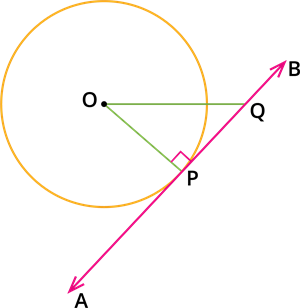PDF chapter test TRY NOW
Statement:
The tangent at any point of a circle is perpendicular to the radius through the point of contact.
Proof for the theorem:
Consider a circle with centre O.
Let AB be the tangent to the circle at the point P.

To prove:
The line OP is perpendicular to AB.
Proof:
Take a point Q other than P on the tangent AB and join OQ.
Here, Q must lie outside the circle.
Thus, OQ is longer than OP.
That is OQ > OP at every point on AB except at P.
Therefore, the point P is at the shortest distance from the centre O.
We know that:
Out of all the line segments, drawn from a point to points of a line not passing through the point, the smallest is the perpendicular to the line.
By the theorem, OP is perpendicular to AB.
Hence, the proof.
Example:
In the above given figure if OP = 3 cm and PQ = 4 cm, find the length of OQ.
Solution:
By the result, \angle OPQ = 90^{\circ}.
So, OPQ is a right angled triangle.
By the Pythagoras theorem, we have:
In a right triangle, the square of the hypotenuse is equal to the sum of the squares of the other two sides.
OQ^2 = OP^2 + PQ^2
OQ^2 = 3^2 + 4^2
OQ^2 = 9 + 16
OQ^2 = 25
\Rightarrow OQ = \sqrt{25}
OQ = 5
Therefore, the measure of OQ = 5 cm
Important!
- By this theorem, we can say that at any point on the circle, there can be one and only one tangent.
- The line containing the radius through the point of contact is also called the normal to the circle at the point.
